Are you a Quiet Speculation member?
If not, now is a perfect time to join up! Our powerful tools, breaking-news analysis, and exclusive Discord channel will make sure you stay up to date and ahead of the curve.
On January 9th, Wizards of the Coast brought the heavy weight of the banhammer down upon Modern, attempting to target several linear decks that ranked among the best-performing archetypes during 2016. On the one hand we had the aggressive, explosive creature combos with a gotcha! element, headlined by Infect. On the other hand we had Dredge, taxing sideboards and punishing anyone who was trying to play normal Magic. Together these archetypes put enormous pressure on the format—interactive decks needed to begin disrupting immediately in the first three turns of the game, but the very strategies suited to this task tended to fold to Dredge's late-game engine. We saw Jund and Bant Eldrazi rise to the task, but few other fair decks were able to navigate the crucible. It's no surprise that this environment favored the non-interactive, with Affinity, Burn, and RG Valakut taking larger-than-normal shares and the slower decks like Tron and Jeskai falling by the wayside. Meanwhile, control players did their best unfair impression, turning to prison strategies like Lantern Control and RW Prison that could cheese out the linear decks with haymakers like Ensnaring Bridge or Chalice of the Void.
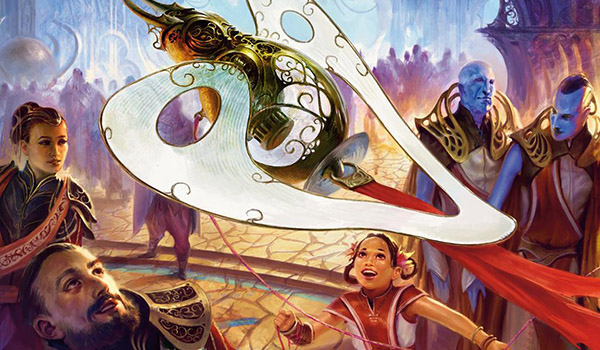
Early indications of the post-banning environment seem to show that Wizards was assiduous in its application of their stated ban policy. The January data bridges the date the bans went into effect, but we can already see the linear decks relaxing their stranglehold. Things appear to be becoming more diverse too—although it's hard to say if this is merely an effect of a metagame in flux, or if we've truly returned to the glory days of a brewer's Modern paradise. My money's on the former—but we shall see.
[wp_ad_camp_1]
Data Collection Methods
First, a note on the data set we're working with. The bans went into effect on MTGO on January 11, while the paper format didn't switch over until the 20th. All told, this means the January data is split about half between the pre- and post-banning environments. Since this was likely to show a pretty muddled picture, we decided to extend the period out one more week. That gives us a few more MTGO Leagues and paper events after the bannings, but more importantly the Top 8 finishes from Star City Games Regionals. For many players this would have been the first large tournament they targeted for post-ban testing. Regionals most likely is the best indicator of the new Modern, and it already shows some pretty big shifts (just one Infect deck across all the Top 8s!) Tune in for Trevor's article later in the week where he'll tackle those results more specifically.
Major paper events were pretty sparse in January, with just two SCG Classics in Columbus and Richmond. The Modern component of the 2017 Super Sunday Series Championship could also be considered a high-profile event, but it suffers from the typical issues related to split-format events. Thus we've included the 3-1-or-better Modern decks as regular paper data points. Finally, with no Grand Prix or SCG Opens since November, our Day 2 metagame data is starting to get pretty stale. Normally we weight that data at 1/3 of the metagame, but given its extreme age in this update I assigned it a weight of 1/8. Altogether our paper data total 643 decks across 85 events.
Regarding the MTGO data, this month I've made a slight tweak. As far as I can tell, Wizards chooses a random sampling of 5-0 League finishes to publish each day. Whatever algorithm they use doesn't preclude duplicate decks, which appear semi-regularly throughout the data. This corresponds to a broader phenomenon whereby in any given month certain usernames tend to dominate the data set, appearing repeatedly across days. These names start to become familiar to anyone who reads the results regularly—they belong, of course, to the grinders and pros who are playing one (or more) events daily, and who thus appear disproportionately in the finishes.
To some extent this bias is warranted, if our goal is to measure the metagame as it stands empirically—you are, in fact, more likely to face these opponents during the month(s) in question. That said, to minimize the skewing effect, moving forward I'll be limiting each username to one finish per day, per archetype. (In January there was one instance of a pilot playing two different decks to 5-0 finishes, both of which were included.)
In addition to Leagues, we have a MOCS monthly and a MOCS playoff to draw from. Together the MTGO data comprise 416 decks across 38 events.
Tier 1
Tier 1 decks are the ones you should expect to face at every Modern tournament. Make sure you show up to your local events and Grand Prix alike with a well thought-out plan to beat these decks—you’re going to face them often, and each one is resilient enough to fight through a lackluster counterplan. Of course another avenue is to pick one of these up yourself, which I generally suggest for anyone not well-versed in a lower-tier deck. Whether you know one of these archetypes inside-out and can tune a killer sideboard for the field, or you want to pick up something new and wing it, these decks certainly have the chops to get the job done.
Tier 1: 1/1/17 - 2/5/17
| Deck | Overall Metagame % | Paper % | MTGO % |
|---|---|---|---|
| Affinity | 6.6% | 6.7% | 6.0% |
| Jund | 6.1% | 7.2% | 4.1% |
| RG Valakut | 5.6% | 5.1% | 6.5% |
| Burn | 5.4% | 5.4% | 5.0% |
| Gx Tron | 5.4% | 5.9% | 5.8% |
| Abzan | 5.0% | 4.2% | 8.2% |
| Bant Eldrazi | 4.8% | 5.1% | 3.6% |
| Infect | 4.5% | 3.7% | 1.9% |
| Dredge | 4.1% | 2.8% | 5.5% |
A cursory glance at the archetypes that comprise our Tier 1 for January implies that little has changed in Modern early after the bannings. Most of these decks were well-represented throughout the year of 2016, and with the exception of Abzan, all were Tier 1 in the December standings. (Note that the appearance of RG Valakut in Tier 1 is not a new development, but rather a function of rolling Titan Breach and Titan Shift together.) Notwithstanding the departure of Gitaxian Probe and Golgari Grave-Troll and the arrival of Fatal Push, Modern appears to be the same format we've always known. However, digging deeper we start to see some pretty striking elements that are indicative of major shifts.
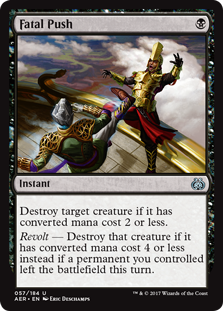 This first appears in the wider-than-normal differentials between MTGO and paper shares for several archetypes. This is nothing new of course. We've often seen the MTGO metagame adapt faster than its paper counterpart, for a variety of reasons like card availability and event frequency. But these discrepancies are usually limited to a reduced number of archetypes, and the gulf is usually just a few percentage points. Here we see four Tier 1 archetypes (Jund, Infect, Dredge, and Abzan) with marked differences between MTGO and paper share. Looked at proportionally, these gaps become even more striking—each of these archetypes is about twice or half as prevalent in one environment as the other. Abzan doubles from 4.2% to 8.2%; Infect loses nearly half its paper share of 3.7% for 1.9% on MTGO; and so on.
This first appears in the wider-than-normal differentials between MTGO and paper shares for several archetypes. This is nothing new of course. We've often seen the MTGO metagame adapt faster than its paper counterpart, for a variety of reasons like card availability and event frequency. But these discrepancies are usually limited to a reduced number of archetypes, and the gulf is usually just a few percentage points. Here we see four Tier 1 archetypes (Jund, Infect, Dredge, and Abzan) with marked differences between MTGO and paper share. Looked at proportionally, these gaps become even more striking—each of these archetypes is about twice or half as prevalent in one environment as the other. Abzan doubles from 4.2% to 8.2%; Infect loses nearly half its paper share of 3.7% for 1.9% on MTGO; and so on.
Remember that the cutoff for bannings went into effect earlier on MTGO, so in addition to its traditional propensity for faster movement the online community got a week-long head start. All in all, these data clearly show a metagame in rapid flux. As we get more data during 2017, I hope to take a comparative look at the pre- and post-banning metagames to get a clearer picture, but for now we're still in a period of conjecture. The weirdest thing here is definitely the way Dredge is posting better MTGO results—my working theory for now is that rumors of the deck's demise have been exaggerated, and that Golgari Thug is an acceptable replacement for Grave-Troll.
Tier 1 Changes: December to January
| Deck | % Change December to January | Overall Meta % 1/1 - 2/5 | Overall Meta % 12/1 - 12/31 |
|---|---|---|---|
| Affinity | +1.3% | 6.6% | 5.3% |
| Jund | -1.4% | 6.1% | 7.5% |
| RG Valakut | +1.1% | 5.6% | 4.5% |
| Burn | -1.5% | 5.4% | 6.9% |
| Gx Tron | +1.6% | 5.4% | 3.8% |
| Abzan | +1.3% | 5.0% | 3.7% |
| Bant Eldrazi | +0.5% | 4.8% | 4.3% |
| Infect | -5.7% | 4.5% | 10.2% |
| Dredge | -2.7% | 4.1% | 6.8% |
Wowzers. Here again we see changes way more plentiful and bigger than is typical. Perhaps predictably, the two decks targeted most directly by the bans (Dredge and Infect) dropped by a good chunk—but that 5.7% drop is enormous. This is the largest change to any archetype I've seen since I began managing the metagame reports last year (although it is the first B&R change I've overseen). The banned decks' loss of share is flanked by a flurry of relatively large movements in virtually every other Tier 1 deck, with the sole exception of Bant Eldrazi. Let's go through each briefly.
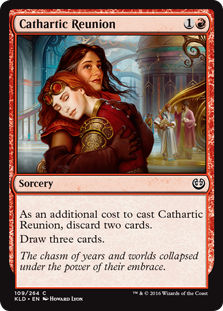 Dredge persists in nerfed form. As I alluded to above, Dredge is still posting a healthy 5.5% of the MTGO metagame, where players have basically switched out Grave-Trolls one-for-one for Golgari Thugs. That's obviously a big downgrade—not only are we dredging for much smaller values, we've lost a major late-game grinding component in the hard-to-kill 10/10 beatstick. These aspects were enough to drop Dredge almost 3 percentage points to 4.1%. That said, Cathartic Reunion is still one hell of an enabler, and in most opening hands a Stinkweed Imp will fare just fine. I think we'll see Dredge settle into a more reasonable role in the new Modern, much like Bant Eldrazi did after the departure of Eye of Ugin. Dredge's days of warping sideboards are likely at an end, but the deck may fall into the characteristic cycling pattern it has exhibited in other formats. All in all, early data shows that Wizards made a good call returning the nefarious Skeleton Troll to his prison cell (that guy always recidivates).
Dredge persists in nerfed form. As I alluded to above, Dredge is still posting a healthy 5.5% of the MTGO metagame, where players have basically switched out Grave-Trolls one-for-one for Golgari Thugs. That's obviously a big downgrade—not only are we dredging for much smaller values, we've lost a major late-game grinding component in the hard-to-kill 10/10 beatstick. These aspects were enough to drop Dredge almost 3 percentage points to 4.1%. That said, Cathartic Reunion is still one hell of an enabler, and in most opening hands a Stinkweed Imp will fare just fine. I think we'll see Dredge settle into a more reasonable role in the new Modern, much like Bant Eldrazi did after the departure of Eye of Ugin. Dredge's days of warping sideboards are likely at an end, but the deck may fall into the characteristic cycling pattern it has exhibited in other formats. All in all, early data shows that Wizards made a good call returning the nefarious Skeleton Troll to his prison cell (that guy always recidivates).
- Infect takes a big hit. My poor, embattled Phyrexians. What did they ever do to you people? All they wanted was to compleat the multiverse so you could live up to your potential and be the best you could be. And look how they're rewarded. A drop by more than half their share in December, bringing them from top deck down to 4.5% of the metagame. The naive interpretation here is of course that Infect can't function without its blue Praetor's invasive Probes, but as a committed pilot of the deck I think that's actually a red herring. In my opinion the loss of Probe is far less important to Infect's fall than the surrounding metagame shifts that the bans engendered.
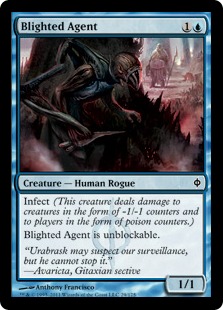 It starts with Golgari Grave-Troll, strangely enough. Dredge terrorized a large number of archetypes during its reign, warping sideboards and deck choices alike. The Phyrexians, however, apparently must have a highly effective zombie-removal system—Infect was one of the few archetypes that generally posted a positive matchup against Dredge. While Dredge could get odds close to 50% with liberal use of sideboard space, this was not a matchup they could ignore. Infect, on the other hand, got to add Distortion Strike and extra Spell Pierces and largely continue on its merry way. So one of our good matchups fell in numbers.
It starts with Golgari Grave-Troll, strangely enough. Dredge terrorized a large number of archetypes during its reign, warping sideboards and deck choices alike. The Phyrexians, however, apparently must have a highly effective zombie-removal system—Infect was one of the few archetypes that generally posted a positive matchup against Dredge. While Dredge could get odds close to 50% with liberal use of sideboard space, this was not a matchup they could ignore. Infect, on the other hand, got to add Distortion Strike and extra Spell Pierces and largely continue on its merry way. So one of our good matchups fell in numbers.
Second, while Infect can survive just fine without the free cantrip (Probe was probably the card I sided out more than anything else) the same couldn't really be said for UR Prowess and Death's Shadow Zoo. At minimum, these decks will have to adjust greatly to continue functioning, and their characteristic explosive starts will be far less frequent. That combined with Dredge's nerfing puts fair decks like Jeskai, Jund, Abzan, and Grixis in much better positioning. These decks have always been the bane of little infecters everywhere, and they recently got access to Fatal Push to boot. To some extent, this is an effect we haven't seen play out yet (see below in the section on BGx). That does lead me to believe some of Infect's drop is self-policing by the Modern community, where players (right or wrong) assume their old deck choice should be sidelined.
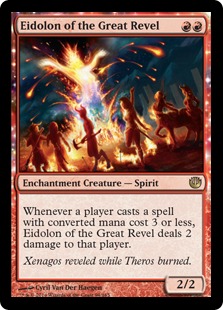 Affinity and Burn switch places. At 6.6%, the robots have surpassed the other two aggro archetypes that outperformed them last month (Burn and Infect), rising to the top position overall. The next largest archetypes are nipping at Affinity's heels, but for now it appears to be an early winner of the bannings. Compared to Infect, it's easy to see why it would be advantaged—both have been premier aggressive archetypes since time immemorial, and Affinity didn't lose any tools. Looking to Burn, which shed about the same amount of metagame share Affinity gained, we can see some secondary cascades of the new environment. Infect was a bad matchup for Affinity and a good one for Burn. As the Phyrexians appear in lower numbers, these archetypes are benefited and punished accordingly. Dredge is yet another unfavorable matchup the robots have to contend with less now. And finally, Burn is itself unfavored against Affinity, and will be negatively impacted by an increase in that deck's share.
Affinity and Burn switch places. At 6.6%, the robots have surpassed the other two aggro archetypes that outperformed them last month (Burn and Infect), rising to the top position overall. The next largest archetypes are nipping at Affinity's heels, but for now it appears to be an early winner of the bannings. Compared to Infect, it's easy to see why it would be advantaged—both have been premier aggressive archetypes since time immemorial, and Affinity didn't lose any tools. Looking to Burn, which shed about the same amount of metagame share Affinity gained, we can see some secondary cascades of the new environment. Infect was a bad matchup for Affinity and a good one for Burn. As the Phyrexians appear in lower numbers, these archetypes are benefited and punished accordingly. Dredge is yet another unfavorable matchup the robots have to contend with less now. And finally, Burn is itself unfavored against Affinity, and will be negatively impacted by an increase in that deck's share.
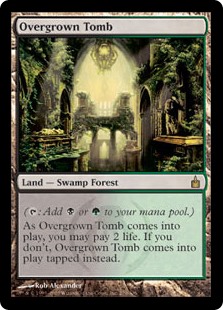 Abzan is up, Jund is down. Abzan took a chunk out of Jund's shares, but the total representation of BGx is about the same as in December. Honestly, I and other commentators had anticipated an increase due to Fatal Push, but we're still in the early weeks of Aether Revolt Modern. The set was released a few weeks after the bannings, so the presence of the new premier kill spell is probably still underrepresented in our data. As for why Abzan would be better than Jund, I can only speculate. If BGx had increased more generally, it would make sense as a foil to the pseudo-mirror, but that wasn't the case. Abzan with its Lingering Souls and Path to Exiles is certainly scarier for Infect, but the slightly durdlier BGx variant was probably just disadvantaged due to general format speed.
Abzan is up, Jund is down. Abzan took a chunk out of Jund's shares, but the total representation of BGx is about the same as in December. Honestly, I and other commentators had anticipated an increase due to Fatal Push, but we're still in the early weeks of Aether Revolt Modern. The set was released a few weeks after the bannings, so the presence of the new premier kill spell is probably still underrepresented in our data. As for why Abzan would be better than Jund, I can only speculate. If BGx had increased more generally, it would make sense as a foil to the pseudo-mirror, but that wasn't the case. Abzan with its Lingering Souls and Path to Exiles is certainly scarier for Infect, but the slightly durdlier BGx variant was probably just disadvantaged due to general format speed.
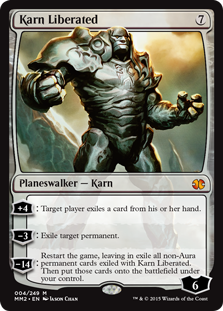 Gx Tron rises to the challenge. We're reporting the green-based Tron decks together because they largely fill the same metagame position and differ in little more than the removal of choice and a few sideboard options. Breaking it down into parts, RG, GW, and BG Tron were all about evenly represented, with BG's shares increasing the most since December. As many people suspected, Tron is another major beneficiary of the new environment. Infect and Dredge were nightmare matchups for the ponderous big-mana deck. At the same time that both were knocked down a peg, Tron's preferred matchup got a shot in the arm in Fatal Push. An increase in Overgrown Tomb alongside fewer Inkmoth Nexuses and Prized Amalgams is good news for Karn et.al. Tron has also benefited immensely from some smart deckbuilding and innovation in its removal suite, that saw a shift to white and black splashes improve its traditional bad matchups. As if that weren't enough, the black versions can themselves use the new tool Fatal Push printed in Aether Revolt.
Gx Tron rises to the challenge. We're reporting the green-based Tron decks together because they largely fill the same metagame position and differ in little more than the removal of choice and a few sideboard options. Breaking it down into parts, RG, GW, and BG Tron were all about evenly represented, with BG's shares increasing the most since December. As many people suspected, Tron is another major beneficiary of the new environment. Infect and Dredge were nightmare matchups for the ponderous big-mana deck. At the same time that both were knocked down a peg, Tron's preferred matchup got a shot in the arm in Fatal Push. An increase in Overgrown Tomb alongside fewer Inkmoth Nexuses and Prized Amalgams is good news for Karn et.al. Tron has also benefited immensely from some smart deckbuilding and innovation in its removal suite, that saw a shift to white and black splashes improve its traditional bad matchups. As if that weren't enough, the black versions can themselves use the new tool Fatal Push printed in Aether Revolt.
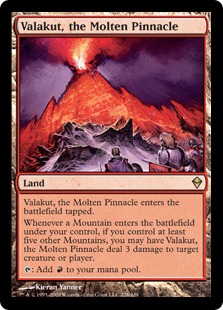 RG Valakut pushes higher. RG Valakut was another major story of 2016, when it rose from obscure fringe status (usually under the name of "Summoning Trap") to become one of the premier archetypes. As I explained in past updates, this archetype can be broken into two distinct builds, Titan Breach and Titan Shift. For this update, we've decided to just start listing them as one archetype, as that does a better job of representing how they fit into a given metagame. These decks tend to struggle against the more linear aggressive strategies like Infect, and excel against fair strategies and Tron, so the bannings were probably a boost. The Valakut archetypes together grew by 1.1%, with most of that attributable to the Through the Breach variants.
RG Valakut pushes higher. RG Valakut was another major story of 2016, when it rose from obscure fringe status (usually under the name of "Summoning Trap") to become one of the premier archetypes. As I explained in past updates, this archetype can be broken into two distinct builds, Titan Breach and Titan Shift. For this update, we've decided to just start listing them as one archetype, as that does a better job of representing how they fit into a given metagame. These decks tend to struggle against the more linear aggressive strategies like Infect, and excel against fair strategies and Tron, so the bannings were probably a boost. The Valakut archetypes together grew by 1.1%, with most of that attributable to the Through the Breach variants.
Tier 2
Tier 2 decks are not as omnipresent as the Tier 1 crop, but they still show up in hearty numbers at the typical tournament. In many ways this tier is the lifeblood of Modern, whence its diversity and “play anything” reputation stems. If these decks aren’t dominating at the moment, they’re still capable of crushing a tournament on any given day—and many of them have been Tier 1 at some point in the past or will in the future. The better acquainted you are with any one of these archetypes, the better choice it represents, and if one of them is your specialty there’s a strong argument to stay the course and keep sleeving it up.
As for preparing to beat Tier 2 decks, you don’t need to dedicate specific sideboard space or do backflips to make your matchups favorable, but at minimum have a plan. You won’t face all of these decks in a tournament, but you’re all but certain to face at least some of them. Welcome to Modern!
Tier 2: 1/1/17 - 2/5/17
| Deck | Overall Metagame % | Paper % | MTGO % |
|---|---|---|---|
| Death's Shadow Zoo | 2.9% | 1.1% | 6.5% |
| Grixis Control/Midrange | 2.7% | 2.3% | 3.4% |
| Ad Nauseam | 2.4% | 2.6% | 3.1% |
| Grixis Delver | 2.4% | 3.4% | 0.7% |
| Abzan Company/Evolution | 2.4% | 3.7% | 0.2% |
| Eldrazi Tron | 2.1% | 1.4% | 3.8% |
| UW Control/Midrange | 1.9% | 1.4% | 3.6% |
| Eldrazi and Taxes | 1.8% | 1.7% | 2.2% |
| Elves | 1.6% | 2.5% | 0.2% |
| Merfolk | 1.6% | 1.6% | 1.2% |
| Lantern Control | 1.6% | 1.1% | 1.2% |
| Griselbrand | 1.3% | 0.9% | 2.2% |
| Amulet Titan | 1.3% | 0.3% | 3.4% |
| RW Prison | 1.3% | 0.6% | 2.2% |
While the changes to Tier 1 happened mostly in share percentage, Tier 2 saw more substantial changes to its roster. New in January are Abzan Company/Evolution, Amulet Titan, Eldrazi and Taxes, Elves, Griselbrand, and UW Midrange, while two archetypes, Jeskai Control and UR Prowess, fell down to Tier 3. Of these archetypes, the one that changed the most was Abzan toolbox strategies, which gained about 1.5%. Again we see a greater-than-normal number of archetypes with significant differences between paper and MTGO showings, which reinforces my narrative about the metagame in transition.
In case you didn't notice above, the total loss of percentage in Tier 1 decks was 11.3%, compared to just 5.8% gains. That means a full 5.5% of the Tier 1 metagame share was redistributed down to Tier 2 and 3 archetypes. That's a good sign that the bannings are working as intended and increasing diversity. We see this diversity present in the Tier 2 metagame shares, with no deck claiming 3% (compared to three decks during December). All of this could be due to adjustments as the Modern community figures out what the best strategies are, but for now it seems a less rarefied metagame is taking form.
There are too many changes here to go over every single one, but I'll try to touch on the most salient ones.
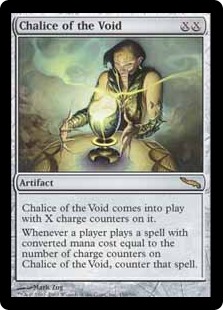 Prison recedes into the background again. Prison strategies enjoyed an uncharacteristically large presence on the 2016 stage. It began with Eldrazi Winter, when Lantern Control was one of the only decks capable of keeping up with the broken and soon-to-be-banned deck. Lantern was later joined by RW Prison as two viable avenues for control-minded players who needed to respond to the linear environment. If you can't play fair and kill/counter all their cards the good-old-fashioned way, perhaps you should just invalidate entire swaths of their deck in a fell swoop. Ensnaring Bridge, Chalice of the Void, Blood Moon, Anger of the Gods—the marquee cards in these decks have the linear metagame written all over them, and they tend to be less impressive against interactive decks. With the linear creature-based decks dropping off somewhat, these decks have lost some of their raison d'être, and we'll probably see them return to a less prominent spot. Lantern Control and RW Prison are still holding on in Tier 2, but they fell by 1.5% and 1%, respectively.
Prison recedes into the background again. Prison strategies enjoyed an uncharacteristically large presence on the 2016 stage. It began with Eldrazi Winter, when Lantern Control was one of the only decks capable of keeping up with the broken and soon-to-be-banned deck. Lantern was later joined by RW Prison as two viable avenues for control-minded players who needed to respond to the linear environment. If you can't play fair and kill/counter all their cards the good-old-fashioned way, perhaps you should just invalidate entire swaths of their deck in a fell swoop. Ensnaring Bridge, Chalice of the Void, Blood Moon, Anger of the Gods—the marquee cards in these decks have the linear metagame written all over them, and they tend to be less impressive against interactive decks. With the linear creature-based decks dropping off somewhat, these decks have lost some of their raison d'être, and we'll probably see them return to a less prominent spot. Lantern Control and RW Prison are still holding on in Tier 2, but they fell by 1.5% and 1%, respectively.
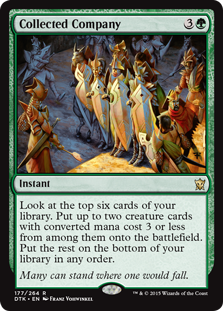 Company's back, baby! Abzan Company has had a wild ride. It ranked among the privileged few able to survive the harsh Eldrazi winter, only to fall almost completely off the map as the subsequent linear metagame took form. As Dredge rose in prominence, poor Abzan Company got hammered by splash damage off of Rest in Peace and Grafdigger's Cage. Now the stage is set for this archetype to return to being a normal part of the meta. Notice that absurd difference in MTGO and paper shares; we've talked about this before, but there's a good chance the difficulty of executing the combo on the online client is to blame. In any case, 3.7% of the paper metagame is a healthy share for a deck that until recently was drifting around the bottom of Tier 3.
Company's back, baby! Abzan Company has had a wild ride. It ranked among the privileged few able to survive the harsh Eldrazi winter, only to fall almost completely off the map as the subsequent linear metagame took form. As Dredge rose in prominence, poor Abzan Company got hammered by splash damage off of Rest in Peace and Grafdigger's Cage. Now the stage is set for this archetype to return to being a normal part of the meta. Notice that absurd difference in MTGO and paper shares; we've talked about this before, but there's a good chance the difficulty of executing the combo on the online client is to blame. In any case, 3.7% of the paper metagame is a healthy share for a deck that until recently was drifting around the bottom of Tier 3.
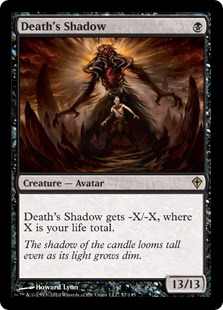 Death's Shadow undergoes a lateral shift. So what gives with Death's Shadow, which was supposed to meet its untimely demise at the end of Wizards' banhammer? It lost 0.7% since December, but the MTGO shares of 6.5% point to a deeper story. Death's Shadow pilots were explicit in saying that the old deck was very dependent on Gitaxian Probe, and that the banning would prove quite unkind to the archetype. In a sense it has—the old Death's Shadow build is all but completely dead—but a new replacement was found pretty quickly. I covered this innovation in a Deck of the Week feature, where I called it Death's Shadow Jund. This build foregoes some of the explosiveness for more consistency in a Traverse the Ulvenwald package. For now it appears the cat isn't out of the bag among the paper Modern crowd, but the MTGO grinders have certainly registered their conviction in the archetype's competitiveness, and it's performing admirably there.
Death's Shadow undergoes a lateral shift. So what gives with Death's Shadow, which was supposed to meet its untimely demise at the end of Wizards' banhammer? It lost 0.7% since December, but the MTGO shares of 6.5% point to a deeper story. Death's Shadow pilots were explicit in saying that the old deck was very dependent on Gitaxian Probe, and that the banning would prove quite unkind to the archetype. In a sense it has—the old Death's Shadow build is all but completely dead—but a new replacement was found pretty quickly. I covered this innovation in a Deck of the Week feature, where I called it Death's Shadow Jund. This build foregoes some of the explosiveness for more consistency in a Traverse the Ulvenwald package. For now it appears the cat isn't out of the bag among the paper Modern crowd, but the MTGO grinders have certainly registered their conviction in the archetype's competitiveness, and it's performing admirably there.
Tier 3
Tier 3 in Modern houses the decks with fringe potential, or those which are simply in a poor position in the current metagame. These decks range from relatively strong decks with scant adoption in the player base, to fragile decks that crumble to variance while mainstays like Burn or Jund draw consistently round after round. That said, Modern draws from an absurd well of card power, and each of these decks can give you a run for your money. You don’t need perfect knowledge of everything they’re doing, but the difference between familiarity and complete ignorance can definitely determine the outcome of a match.
Playing these decks isn’t advised, unless you know them inside-out or have some specific reason why you think they’re underrepresented. Of course, they are also worth a look as fun decks to battle if you’re less concerned about winning and want to delve into the deeper end of the Modern pool.
Tier 3: 1/1/17 - 2/5/17
| Deck | Overall Metagame % | Paper % | MTGO % |
|---|---|---|---|
| UR Prowess | 1.1% | 0.6% | 1.9% |
| Kiki Chord | 1.0% | 1.4% | 0.2% |
| Living End | 1.0% | 1.1% | 1.0% |
| Jeskai Control | 1.0% | 1.1% | 0.7% |
| Knightfall | 1.0% | 0.9% | 1.2% |
| Esper Control | 1.0% | 1.1% | 1.0% |
| Blue Moon | 1.0% | 0.8% | 0.7% |
| Skred Red | 0.9% | 1.1% | 0.7% |
| Scapeshift | 0.8% | 1.1% | 0.2% |
| Bushwhacker Zoo | 0.7% | 0.8% | 0.2% |
| Faeries | 0.7% | 0.9% | 0.5% |
| Jeskai Midrange | 0.7% | 0.6% | 0.5% |
| Bogles | 0.7% | 0.8% | 0.7% |
| Death and Taxes | 0.6% | 0.6% | 1.0% |
| Gifts Storm | 0.6% | 0.5% | 1.2% |
| Mardu Control/Midrange | 0.6% | 0.6% | 0.2% |
If the upsets in Tier 1 and 2 were clear indicators of the seismic impact of the Probe and Grave-Troll bannings, Tier 3 changed pretty much exactly as we might expect. There were a larger number of decks that sublimated one rung up to Tier 2, but some number of these shifts do happen every month. A few decks fell off entirely, while other surfaced after some time off the radar. The percentage changes in the lower decks are too small to reliably say whether they're related to the bannings per se. Skred Red, for example, seems to have enjoyed a minor bump from the GP Dallas publicity, but who knows if this deck will stick around. There are, however, three more noticeable changes.
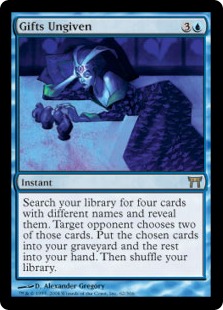 The first is just that UR Prowess lost half its share, dropping from Tier 2 in December. As with Death's Shadow, this deck's aficionados may yet find a way to resuscitate the archetype, but Probe was a pretty central piece. Second, we see Esper Control hit 1% of the metagame. Control strategies without access to red were the biggest gainers in the printing of Fatal Push, and Esper Control may finally be viable. That said, I'm not confident Push is exactly the reason here—UW Control/Midrange strategies have been on the rise for several months as well. This month the UW control strategies pushed into Tier 2 with a 0.5% bump. It could be that a less linear metagame simply favors these fair midrangey decks, outside of any particular card considerations.
The first is just that UR Prowess lost half its share, dropping from Tier 2 in December. As with Death's Shadow, this deck's aficionados may yet find a way to resuscitate the archetype, but Probe was a pretty central piece. Second, we see Esper Control hit 1% of the metagame. Control strategies without access to red were the biggest gainers in the printing of Fatal Push, and Esper Control may finally be viable. That said, I'm not confident Push is exactly the reason here—UW Control/Midrange strategies have been on the rise for several months as well. This month the UW control strategies pushed into Tier 2 with a 0.5% bump. It could be that a less linear metagame simply favors these fair midrangey decks, outside of any particular card considerations.
Finally, we have a new deck in Modern, sort of. I originally planned to roll all the "Gifts Storm" decks into the same category of Storm, but as I entered the data I discovered it had enough of a showing to reach Tier 3 by itself! While Storm pilots bemoaned the banning of Gitaxian Probe as unfair punishment to a deck that was already struggling, they were quietly gifted with a new tool in Aether Revolt: Baral, Chief of Compliance. As with many things Modern, simply jamming the card into old builds may have proved lackluster, but a slight shift in deck construction bore fruit. Gifts Ungiven has generally been a little too slow for Modern, but this deck has a full eight ways to make it cost three mana. If you can untap after doing that (especially if your Medallion is still in play) you're virtually guaranteed to kill the opponent on turn four. To make room, they've cut the Pyromancer Ascensions. This may indeed be the new face of a Probeless Storm.
Predicting the Metagame
I'd like to begin offering up my views of where the metagame might move in future updates, but for now I'm pretty beat. This was obviously a pretty important month for metagame changes, and it will be interesting to see how they are reinforced or attenuated in the coming months.
In the meantime, we have another article from Sheridan set to run this week, and the Merfolk Primer is almost ready to roll out. Rather than delay that while all the others are finished, I will probably be pushing it live sometime this month before setting to work on the next one. Hopefully you'll find them worth the wait. For now, thanks for reading, and I'll see you next Monday.





LOL as per usual BW Tokens doesn’t even make the list. Gotta love playing a deck that no one else plays, despite it easily being Tier 2 power wise.
On a different note, no mention of the recent trend of Affinity to run Bitterblossom sideboard? Could be relevant to Affinity going forward.
Interesting stuff for sure. I’m all in on Gifts Storm as a good deck – it’s wonderfully resilient, and able to kill in more than one way, all of which makes it a powerful choice. Graveyard hate seems to be receding, which is why decks like it and Abzan Company can be successful. The choice to combine the Valakut variants also makes some sense, given that they are pretty similar in terms of strategy and that the choice between Through the Breach and Scapeshift seems to be meta- and preference-dependent. I also think a renaming for Death’s Shadow is in order – it’s no longer a Zoo deck.
A lot of those Esper Control numbers are people playing Esper Transcendent. It’s been undergoing testing for awhile and has been getting honed quite well. My 2 main decks are Burn and Infect and it seems like both of them are still quite viable choices for SCG Indy in 2 weeks. Ritual Gifts Storm is pretty much completely replacing Finkel’s PA Storm online. Believe he had a video of himself playing the new deck and it looked pretty rough, but the deck is solid. I’ve even seen some builds running a copy of Jace’s Sanctum to guarantee a 3rd discount option in a Gift pile. Really liking the Merchant Scroll tech too.
Yeah, I saw that Scroll tech and bought 3 sets at ~$0.95/card in anticipation of a spike. I wouldn’t want to be someone who realizes they need them too late to get them cheap.
I have a set of Scrolls from when I had been working on building High Tide but got dejected by the price of Candleabras so I stopped. One of the more powerful tutors that sees nearly no play in Modern.
Thanks for doing the update! Info here is valuable, and very interesting to see how the game unfolds.
Can someone explain to me to me why you have Eldrazi and Taxes and Death and Taxes listed as 2 separate decks?
E&T is just a Variation of D&T. Is it not misrepresentation of the metagame to list them separately?
At least they’ve stopped calling it Hatebears…
…so now there’s just the rest of the internet and all the announcers left to go.
D&T is more typically gw with arbiter, heirarch, etc while eldrazi and taxes is much more explicitly W/colorless/b and eschews the mana dorks in favor of just running vials. You have to draw lines somewhere for hatebears, D&T, and eldrazi and taxes, and from what I can tell they’ve chosen the lines as inclusion of mana dorks and inclusion of aether vials.
Their all Variations on Death and taxes. theres a version for mono white and every two color pain that includes white. Their are even a few Abzan and Bant Variaties. they are all just variations on a theme. Eldrazi and taxes is a Square in the Death and Taxes Rectangle so to speak.
As to drawing the lines Modern Nexus has changed it multiple times over the last few updates. At one point they were correctly all grouped together and now they’re separated out again and that’s what i’m trying to figure out why.
Lol useless numbers
So you averaged preban infects 10 with postban 1 to get 4.5? Thats a metagame share of Shredinger Infect))
Dredge is also not t1 at all now
Btw your database should be very big if you dont give 8rack t3 status. Or its not big enough if you dont recognise decks 6 finishes on mtggoldfish